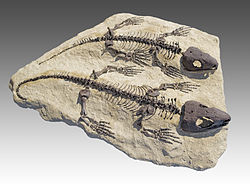Bayloria
|
Captorhinus Temporal range: Cisuralian, 280–270.6 Ma |
|
|---|---|
 |
|
| Two C. aguti specimens, Cisuralian (299-270 mya), Oklahoma, United States | |
| Scientific classification | |
| Kingdom: | Animalia |
| Phylum: | Chordata |
| Class: | Reptilia |
| Family: | †Captorhinidae |
| Genus: |
†Captorhinus Cope, 1895 |
| Type species | |
|
†Captorhinus aguti Cope, 1895 |
|
Captorhinus is an extinct genus of captorhinid reptiles that lived during the Permian period. Its remains are known from North America, Europe, India and Africa.
While there are several forms of Captorhinus, there are three main species that are the best known. The previously mentioned Captorhinus aguti is the type species of Captorhinus, but there is also a fair amount of material collected on Captorhinus magnus and Captorhinus laticeps.
The most distinguishable trait of Captorhinus is its namesake: the hooking of the snout from prominent ventral angulation of the premaxillary process. Other notable characteristics include the dorsally positioned alary process of the jugal on the medial surface and flushed with the orbital margin, the retroarticular process longer anteroposteriorly than broad, and the anteriormost dentary tooth strongly procumbent. The posterior teeth are either chisel-shaped or ogival. Until the late 1990s, Captorhinus was diagnosed by the presence of multiple rows of marginal teeth on the maxillary and dentary bones. However, single-rowed captorhinid elements have been discovered, proving this hypothesis incorrect.
Although a subfamily of Captorhinidae, Moradisaurinae, also possessed multiple-tooth-rows, the best-known type species Captorhinus aguti clearly acquired multiple-rowed-teeth independently. In contrast to the teeth rows in moradisaurines, the C. aguti rows are oriented obliquely to the margins, where each row is followed posterolaterally by the next one. The toothed areas of the maxilla and dentary are broader in C. aguti than in single-tooth-rowed captorhinids.
The vertebral structure in C. aguti is that commonly possessed by primitive reptiles. The centra are amphicoelous and notochordal, with swollen, relatively massive neural arches. The vertebral column is differentiated into presacral, sacral, and postsacral or caudal vertebrae.
Similarly to extant reptiles, C. aguti has a functional “mesotarsal” joint. It divides the tarsus into a proximal and distal unit, where the centrale is linked mechanically to the proximal (astragalus-calcaneum) unit. The increased flexibility due to this multiple-jointed arrangement allowed for the articulations between the centrale and first three distal tarsals on the medial side of the mesotarsal joint to have mechanical independence from the lateral articulation between the astragalus-calcaneum and the fourth and fifth distal tarsals. This is almost certainly closely correlated with the primitive sprawling step cycle. Due to the shape of the distal femoral articulation, Captorhinus aguti would have had little capacity to compensate for lateral movement of the femur.
...
Wikipedia
